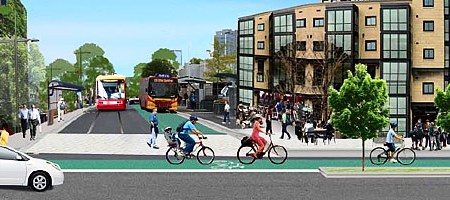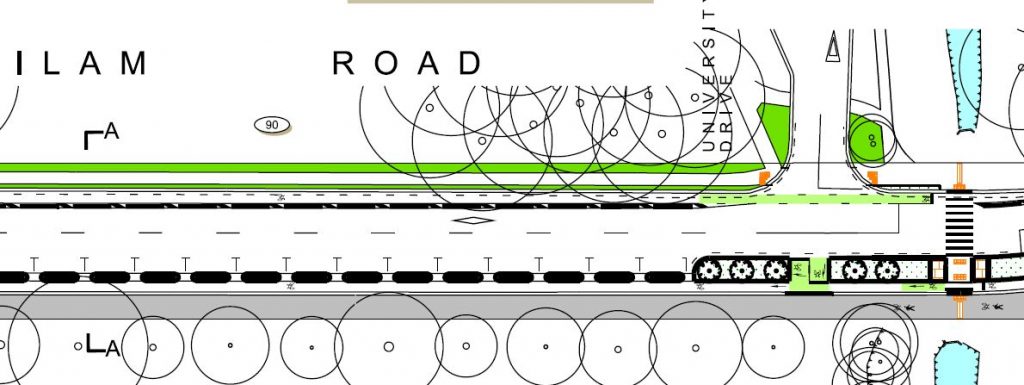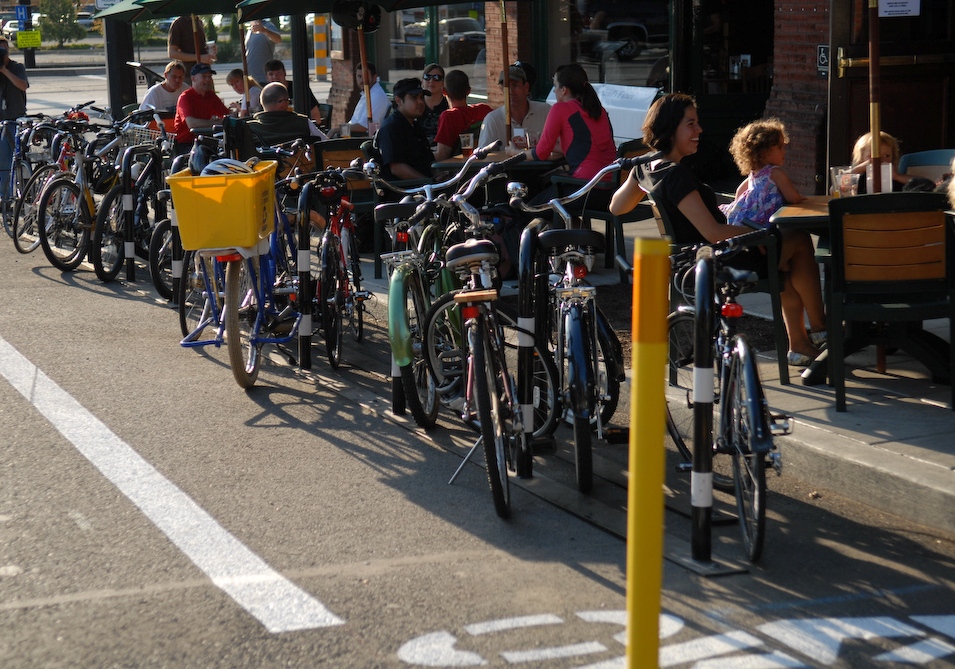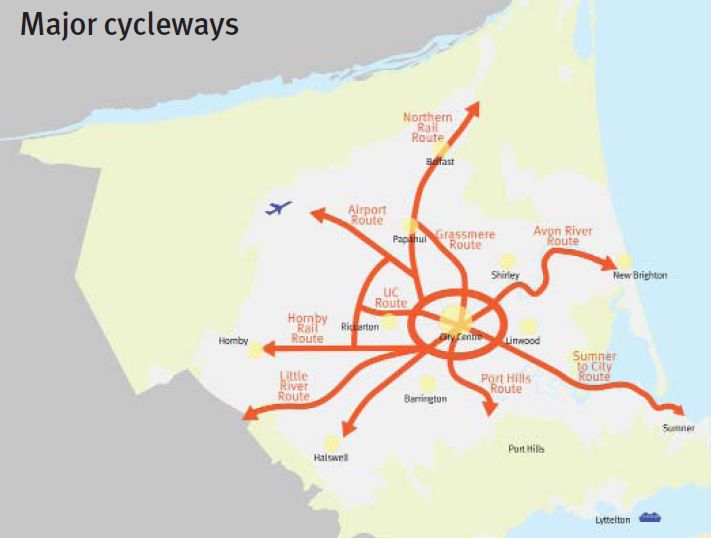The draft Transport Plan for central Christchurch has attracted a lot of comment both positive and negative about its impact on cycling. Now the Council’s Chch Transport Strategic Plan has just been finalised too, setting a city-wide 30-year vision for transport in Christchurch that also appears quite cycle-friendly. Probably one of the biggest concerns is how quickly (and how well) the rhetoric will turn into reality on the ground.

Spokes Canterbury, in commenting optimistically on CERA’s draft Plan, called for the city’s agencies to “develop a ‘1000-day Cycling Plan‘ that will see tangible and innovative changes in cycling provision and an increase in numbers within 3 years.” So what might such a Cycling Plan look like?
Firstly, why 1000 days? Well, the original CERA plan had a convenient 100-day time-limit and the transport component has taken another 100 days. However, you won’t get much physically built in 100 days, whereas in 1000 days (just under 3 years) you could expect to make some significant progress. There are some notable examples of dramatic changes happening in such short time frames, such as Seville, Spain (6000 bike trips up to 50,000 in 3 years after constructing 70km of bike tracks and other cycle-friendly initiatives) and Montreal, Canada (35% growth in numbers over 2 years following separated cycleways and bike-share scheme).
If we take the end of next March as our baseline (remembering that the final CERA Plan won’t actually be finalised until after February next year) then 1000 days would take you until the end of 2015. That’s a full 2½ years into the next Council Long-Term Plan (2013-22), the expenditure for which is currently being planned for. Although the CERA plan is only for the central city, it is sensible to consider city-wide initiatives because the two plans will feed off each other – to get cycle numbers in town you also need better cycling in the ‘burbs too.
So what could you easily do in 1000 days?
- Actually let’s start with an easy “100-day Plan” now: get the Ilam Rd separated cycleway constructed, to demonstrate what could be done (that gives them until mid-March, which should be do-able: it’s about to go to Council for approval – 6MB)

- Introduce 30km/h speed limits in all existing traffic-calmed neighbourhoods around the city (e.g. Addington, Papanui, Riccarton clusters), suburban shopping streets (like they’ve done in Wellington) and downtown.
- Install cycle route signage to show people the existing cycle-friendly routes we already have. There’s already some promising examples of this along the new southern motorway cycleway:

- For the transitional city we keep hearing about: install lots of “PPP Infrastructure” – not the kind that Government is currently keen on, but “paint, planters, posts” to help provide separation for cycling quickly and easily (actually “parking” is another useful separator too). They were pretty quick to remove cycle lanes when they wanted to last year; I’m sure it’s just as quick to add them. More permanent facilities can come later after the layout details have been fine-tuned and their success demonstrated.
- Install more bike parking; get more (good quality) racks in at the key destination spots (town, shopping areas, recreation).

- Implement a “quick wins” programme like that currently in Auckland, where anyone can suggest improvements to little pinch-points or missing links that make cycling just that little bit harder. Provide a relatively small pot of money to tackle the easy ones, e.g. remove barrier posts on alleyways, add missing kerb ramps, build little sections of new/widened pathway, new intersection cycle markings where there’s already the space for it, remove one badly located carpark, fix a storm grate or service cover, and so on.

- Council have instructed its Environment & Infrastructure Committee to identify 4-5 key cycling projects that can be implemented sooner rather than later. So significant planning/design/consultation should be completed (if not some construction already) on the first few major city cycle routes. It would be nice to think that we could complete at least one significant route in the 2013/14 year (could probably get a neighbourhood greenway route constructed reasonably quickly) and another one in 2014/15.

- Get some cycle-friendly events happening. Kickstart the previous “Season of Cycling” programme and also include some Council-organised events (remember Park-to-Pier?). A “Sunday Parkways” ciclovia would be a great one; we could also resurrect a few of the previous Spokes Rides.

Perhaps you can think of other relatively easy ways to get some runs on the board.
What else should be in a 1000-day Cycling Plan?

How about what Bogota does but on a smaller scale – maybe only over summer or monthly: “Ciclovia happens once a week in Bogota, every Sunday between 7am and 2pm. 120km of roads are shut to cars and opened up to cyclists, walkers and people to enjoy. It’s fun, with around 30% of locals, or 2 million people, taking part.”
Great idea Joy, we looked into doing this a couple of years ago ……. you would not believe how much paperwork and expence is attached in doing something so simple. I have seen them for myself in other countries and they seemed very simple to organise and everyone enjoyed them.
The NZ paperwork nightmare was enough to convince me I had better things to do! …… shame really.
Well, the Christchurch City Council should be driving this initiative. As is pointed out above, it gets the masses riding, which I believe is one of CCC’s objectives. Imagine if we had a mayor who declared “I will make this happen”…
Can we have a system to collect lots of quick win ideas? Why not add a web page, with links to a Chch map, for cyclists to add in our quick win ideas. I’ve sent a couple in CCC but I’d prefer to allow discussion about different ideas.
Are the Christchurch Strategic Transport Plan 2012 and the Christchurch Cycle Design Guidelines 2013 still good policy? I know the Christchurch Cycle Design Guidelines Part B: Revision B refers to a Part A, but I can’t find that one.
Part A *is* the 2013 Design Guidelines (i.e. the conceptual designs). Part B developed the details based on this, although these days the NZTA Cycling Network Guidance is also becoming the national standard.
Ah, that is good to know. Thanks. I plan to reference these in my oral submission regarding the DEMP (in case you were wondering how I keep digging up these year-old posts), namely the proposition that separated facilities should be preferred for arterial roads and be considered for collector roads. Random side remark: I love the fact that Cycling network guidance displays a picture from Christchurch as its header. Very appropriate.